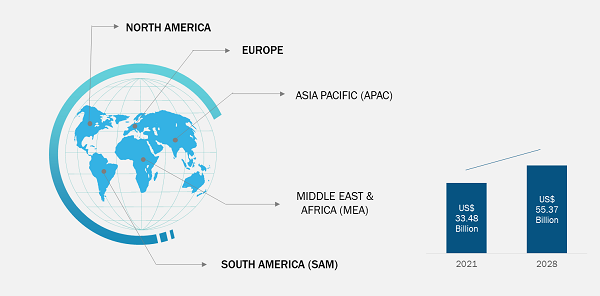Growth in Incidences of Chronic Diseases Catalyzes Stroke Management Market
According to our latest market study on "Stroke Management Market Forecast to 2028 – COVID-19 Impact and Global Analysis – by Type, Application, and Geography," the market is expected to grow from US$ 33.48 billion in 2021 to US$ 55.37 billion by 2028; it is expected to grow at a CAGR of 7.5% from 2022 to 2028.

Stroke Management Market Growth Opportunities by 2031
Download Free SampleStroke Management Market Size and Forecasts (2021 - 2031), Global and Regional Share, Trends, and Growth Opportunity Analysis Report Coverage: by Type (Diagnostic and Therapeutic) and Application (Ischemic Stroke and Haemorrhagic Stroke), and Geography (North America, Europe, Asia Pacific, and South and Central America)
Source: The Insight Partners Analysis
The rising incidence of chronic diseases, including hypertension, hyperlipidemia, and diabetes; technological advancements in the diagnosis and treatment of stroke; continuous increase in the number of tobacco users; and rise in the geriatric population are boosting the stroke management market growth. However, slow drug approval and the huge cost associated with procedures involved in stroke treatment and diagnosis are hampering the market growth
Hypertension is the leading risk factor for stroke as blood pressure higher than 140/90mmHg can damage the blood vessels that supply blood to the brain. Furthermore, diabetes is also a major cause of stroke. As per the American Stroke Association, people with diabetes have twice the chance of having a stroke and may also witness the early onset of stroke. Further, within every two minutes, an adult with diabetes is hospitalized due to stroke in US, as per the same data. As a result, the demand for stroke medications is increasing continuously, and it is expected to grow tremendously in the coming years.
The healthcare expenditure has created ample opportunities for developing nations to provide better services and facilities to their people. Adoption of available treatments, including the application of tissue plasmogen activators, anticoagulants, antiplatelet drugs, and antihypertensives, is likely to rise in emerging regions such as Asia-Pacific and Middle East & Africa. These regions are investing a significant amount in their healthcare sectors, and the awareness regarding health has notably increased. Additionally, the increasing incidences of other stroke-associated risk factors such as atherosclerosis, arrhythmia, cardiac structural abnormalities, and obesity are offering potential opportunities for the stroke management market.
Innovation in technology is one of the factors influencing the market growth. The increasing adoption of MicroTransponder Vivistim Paired VNS System (Vivistim System), which is the first FDA-approved drug-free treatment of stroke, holds growth potential in the stroke management market during the forecast period. Moreover, increasing awareness about stroke results in a sudden rise in the diagnostic rates of the disease, which ultimately increase the demand for stroke targeting drugs. The recombinant tissue plasmogen activators proved to be the most effective treatment for ischemic stroke and are currently prescribed as first-line treatment.
Based on type, the stroke management market is bifurcated into treatment and diagnostic. The treatment segment accounted for a larger market share in 2021, and it is expected to retain its dominance during the forecast period. In August 2021, MicroTransponder Inc. received FDA approval for Vivistim System, a first-of-its-kind stroke rehabilitation system, for the treatment of moderate to severe upper extremity motor deficits associated with chronic ischemic stroke. Moreover, the diagnostic segment is expected to witness the highest CAGR from 2022 to 2028.
Based on application, the stroke management market is bifurcated into ischemic stroke and haemorrhagic stroke. The ischemic stroke segment accounted for a larger market share in 2021, and it is expected to dominate the market over the forecast period. Various drugs such as Ticagrelor, Alteplase, and Clopidogrel, are currently available for the management of ischemic stroke, while few of the candidates are under investigation for treatment and diagnosis of ischemic stroke, and many new devices and drugs are expected to receive approval in the near future. Further, drugs such as neuropeptides are also emerging as novel treatments for stroke, and virtual reality (VR) based therapies are also demonstrating positive effects in the treatment of chronic stroke in clinical trials.
Abbott Laboratories, B Braun Melsungen AG, Boston Scientific Corporation, Bristol Myers Squibb Co., Cardinal Health Inc., General Electric Company, Glaxosmithkline Plc, Medtronic Plc, Merck and Co. Inc., and Siemens AG are among the leading market players profiled during the study. Several other major companies were analyzed during this study to get a holistic view of the stroke management market.
Contact Us
Phone: +1-646-491-9876
Email Id: sales@theinsightpartners.com